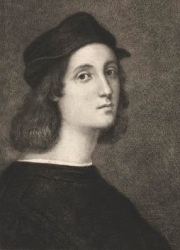  Raphael, born April 6, 1483, was an Italian painter and architect of the Italian High Renaissance. Raphael is best known for his Madonnas, and for his 'School of Athens', the most famous of Raphael’s paintings and one of the most significant artworks of the Renaissance.
Raphael, born April 6, 1483, was an Italian painter and architect of the Italian High Renaissance. Raphael is best known for his Madonnas, and for his 'School of Athens', the most famous of Raphael’s paintings and one of the most significant artworks of the Renaissance. The Renaissance, or 'rebirth' of classical humanist art, philosophy, science, literature and more, dominated Italy and spread throughout Europe from the 14th to 16th centuries A.D.; the term 'High-Renaissance' refers to the mid-point and height of the Renaissance period, the most exceptional period for the production of Renaissance art. Raphael, Leonardo da Vinci, and Michelangelo are all considered High-Renaissance artists. The art of Raphael is known for many things. One of these is its amazing use of perspective. Another is a clear and rich use of colour. His art is also known for the anatomical correctness of its figures. Raphael painted in the classical style popular during the Renaissance. This style followed principles of ancient Greek and Roman art, and was also concerned with classical themes, styles, and imagery. The people in his paintings are known for their nobility, grace, and dignity. Raphael gained quite a reputation as an artist at a relatively young age, and became a sought-after artist during his lifetime. From 1504 through 1507, Raphael produced a series of 'Madonnas', which were seen as an extrapolation of the works of da Vinci, one of Raphael's contemporaries. Raphael's experimentation with this theme culminated in 1507 with his painting, La Belle Jardinière. Many of Raphael's works are well-known. In 1508, Pope Julius II commissioned him to work for the Vatican; one of the works he completed there was the School of Athens, which is considered to be his masterpiece. This painting does not depict an actual school; rather, it contains portraits of all the key philosophers in classical Western thought. Another of Raphael’s famous paintings is the Marriage of the Virgin, depicting Mary’s marriage to Joseph. In this vividly coloured painting, Raphael presents Joseph as an old man, and he shows other suitors of Mary unhappy with the marriage. After about 1512, Raphael had begun to work on architecture. The pope hired Raphael as his chief architect; he created the design for a chapel in Sant' Eligio degli Orefici. He also designed Rome's Santa Maria del Popolo Chapel, and an area within Saint Peter's new basilica. Raphael's architectural work was not limited to religious buildings; it also extended to designing palaces. Raphael was engaged to Maria Bibbiena, a Cardinal's niece. However, Raphael was known to have had many affairs, and to have been in love with a baker's daughter - Margherita Luti. Luti was believed to have been Raphael's mistress and model, and many thought she was the great love of his life. Raphael died in 1520 at the young age of 37, but he is remembered as one of the best and most influential Renaissance artists. His art can still be viewed today throughout various locations in Italy and museums around the world. The representation of women in Renaissance nude paintings Artists celebrated the female form, depicting women as symbols of beauty, fertility, and sensuality. Paintings such as Botticelli's 'The Birth of Venus' epitomized the idealized female nude, showcasing the artists' mastery in capturing the delicate curves, radiant skin, and graceful poses of their subjects. These artworks not only celebrated the beauty of the human form but also served as a reflection of changing societal attitudes towards nudity, gender, and the concept of idealized beauty. Ever since the Renaissance, the nude - the unclothed human form - has been one of the defining features of art in Europe. The rise of the nude in art in the Renaissance was driven by a revival of interest in Greek and Roman art, which is centered on the body. In Italy and later northern Europe during the late 1400s and early 1500s, drawing of undressed models became common practice for artists, and has continued to this day. Nevertheless, the use of nudes in art, particularly religious art, was controversial during the Renaissance. Images of beautiful bodies can be highly sensual, which made some observers uncomfortable - then as much as now. View large images of Raphael's most famous paintings, with descriptions:
|